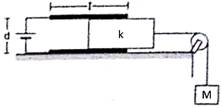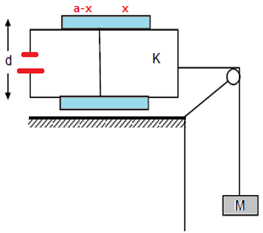Consider the situation shown in figure. The width of each plate is b. The capacitor plates are rigidly clamped in the laboratory and connected to a battery of emf Є. All surfaces are frictionless. Calculate the value of M for which the dielectric slab will stay in equilibrium.

Let the battery connected to the capacitor be of potential V.
Let the length of the part of the slab inside the capacitor be x.
b – Width of plates
The capacitor can be considered to be two capacitors which are connected in parallel.

The capacitances of the two capacitors in parallel is given by –
![]()
![]()
C1 is the part of the capacitor having the dielectric inserted in it and C2 is the capacitance of the part of the capacitor without dielectric.
As, C1 and C2 are in parallel therefore, the net capacitance is given by![]()
![]()
![]()
This dielectric slab is attracted by the electric field of the capacitor and applies a force
The direction of force is in left direction.
Let assume that electric force of magnitude F pulls the slab toward left direction.
Let there be an differential displacement dx towards the left direction by the force F.
The work done by the force
![]()
Let V1 and V2 be the potential of the battery connected to the left capacitor and that of the battery connected with the right capacitor
With increase in the displacement of slab, the capacitance will increase, hence the energy stored in the capacitor will also increase.
In order to maintain constant voltage, the battery will supply extra charge, and gets damage .
Therefore the battery will do work.
Now,
Work done by the battery
= Energy change of capacitor + work done by the force F on the capacitor
![]() 1)
1)
Let’s take the differential charge dq is supplied by the battery, and the change in the capacitor be dC
We know that energy in capacitor dWB
![]()
we know q = cv
⇒![]() 2)
2)
And force F is given by,
![]()
![]()
From 1) and 2)
![]()
![]()
![]()
![]()
In order to keep the dielectric slab in equilibrium, the electrostatic force acting on it must be balanced by the weight of the block attached.
Therefore,
![]()
![]()